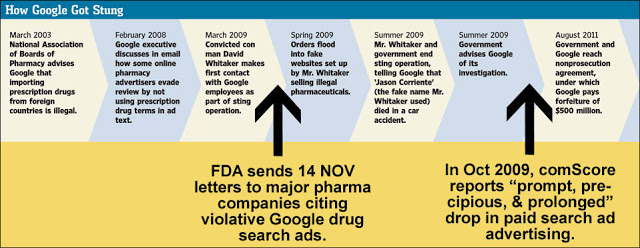Con Artist Reveals All About Google Drug Ad Sting – How FDA May Have Entrapped Google Using Those 14 “Infamous” Notice of Violation Letters
In an interesting article in today’s Wall Street Journal, a convicted con artist details how he was employed by federal agents — including agents of the FDA’s Office of Criminal Investigation — to lead a sting operation against Google’s illegal drug ad operation (see story here). Recall that last summer Google agreed to pay $500 million to settle DOJ charges that it helped illegal online pharmacies target ads through its AdWords platform. It was one of the largest forfeitures ever paid in the U.S. (see “Google Settles with DOJ – Admits Aiding Illegal Online Drug Sales“).
“It was very obvious to Google that my website was not a licensed pharmacy,” said David Whitaker, the prisoner who acted in the sting. “There was a part of me that felt bad,” Mr. Whitaker wrote in his account of the undercover operation viewed by The Wall Street Journal. “I had grown to like these people.” But, he said, “I took ease in knowing they.. knew it was wrong.”
What is of interest to me is the timeline revealed in the WSJ article. I added a couple of events to this timeline shown below (click on the image to enlarge it for better readability).
Mr. Whitaker made first contact with Google in March 2009. On April 2, 2009, FDA made public those “infamous” 14 notice of violation (NOV) letters that effectively shut down Rx drug search advertising on Google. In October 2009, comScore data was released that documented this “prompt, precipitous, and prolonged” drop in paid search advertising (see the chart here).
At the time of the announcement of the Google settlement, I suggested that because of FDA’s involvement in the case, the agency delayed issuing guidance relating to the proper use of Google Adwords for branded Rx advertising. I suggested that the FDA did this to force Google to the bargaining table and to ultimately accept the draconian settlement terms mentioned above. In other words, FDA was holding Google’s pharma Adword business “hostage” until a settlement was reached. See my argument here.
Looking at the above timeline, however, I now believe the 14 letters were sent so that Google might be more easily persuaded to run illegal drug ads to make up for the revenue lost from legitimate Rx drug ads. If true, this looks like a form of entrapment.
Keep in mind that the type of ads targeted in those 14 letters had been running for many years and that I, for one, maintained they were illegal starting way back in 2006 (see The “Girl from Google”). At the time, I submitted a written complaint to the FDA. Why did the FDA wait almost 3 years before getting around to stopping these ads? The answer, I believe, is what I surmised above — it was simply a ploy to incentivize greedy Google ad executives to fall for the sting. According to the WSJ article, Google’s ad executives “worked with Mr. Whitaker to find a way around Google rules.”
P.S. Google may have tried an “end run” around the entrapment by coming up with a new ad format for Rx drugs that addressed the issue cited in the 14 FDA letters. This format was announced at the November, 2009, public hearings (see “Is Google the New FDA?“). The ad was actually “beta” tested by Bayer, but to date the FDA still has not formally approved the format and not many other drug companies have used it.









![6 Digital Tools at the Center of Healthcare Digitalization [INFOGRAPHIC]](http://ec2-54-175-84-28.compute-1.amazonaws.com/pharma-mkting.com/wp-content/uploads/2021/04/6DigitalTools_600px-100x70.jpg)




